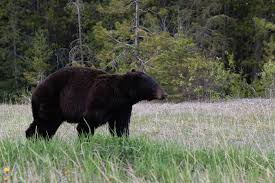The mountains and forests that make for great hiking and camping also serve as prime bear habitat. While living and recreating with bears is nothing new in Vermont and negative incidents in the backcountry are rare, it is important to remember that they do occur. This is the time of year in Vermont where you start to hear about bear activity in the mountains.
 The Green Mountain Club worked with agency partners from Vermont Fish & Wildlife, Vermont Department of Public Safety, and Forests, Parks and Recreation to install bear-safe food storage containers and signs educating hikers about proper food preparation and storage in the backcountry.
The Green Mountain Club worked with agency partners from Vermont Fish & Wildlife, Vermont Department of Public Safety, and Forests, Parks and Recreation to install bear-safe food storage containers and signs educating hikers about proper food preparation and storage in the backcountry.
Bears are opportunists; they are attracted to food and smells found at campsites and if rewarded with successful foraging, can become habituated to human food. Following Leave No Trace Principles and keeping food secure will allow hikers to be able to continue to camp in bear active areas.
These simple guidelines will ensure the safety of you, hikers following in your footsteps, and bears who inhabit the area around you:
- Cook meals away from your tent or shelter.
- Do not eat in your tent or shelter.
- Do not leave food scraps when preparing your meal or cleaning up.
- Secure food and other smellables (toothpaste, soap, deodorant, bug spray, etc.) in a bear-proof container or hang it in a tree at least 100 feet away from camp.
- Pack out and properly dispose of all garbage and waste.
- Do not store or leave food in shelters or at tent sites. (Cans hanging in shelters should not be used for food storage.)
- If a bear enters your campsite, yell and make noise to scare it away.
While bears can be dangerous and have the capacity to hurt humans, they are typically shy and elusive. More often than not, they will sense your presence in the woods and move away without you ever knowing they were there.
In rare cases, when you do see a bear, you can do the following to keep yourself and the bear safe:
- Remain calm.
- Back away slowly and maintain eye contact.
- If a bear approaches you, make noise, wave your arms above your head, and try to scare it away.
- Do not turn and run, as this may trigger the bear’s instinct to chase you.
- If attacked, fight back with all means available and do not play dead.
Hikers on Vermont’s trails have coexisted safely with bears and other wildlife for generations. This is one of the reasons that many of us enjoy spending time in Vermont’s woods. It is our responsibility to be bear aware and to keep food secure in order to protect ourselves and keep the bears safe and wild.
For more information on living and recreating with black bears, please visit the Vermont Fish & Wildlife Department website.



















Thanks for the information on Black Bears. I have a camp in Corinth and hike with my dog on numerous occasions. I am aware that I may very well meet a bear one of these times, so information I can get will be helpful.
I know in the Adirondacks the BearVault canisters are not allowed since the black bears seek them out. Is this the case along the LT, particularly in the southern section in the Green Mountains? Or are BearVaults ok?
Bear canisters are not required in the Green Mountains so there are no rules around which containers to use.